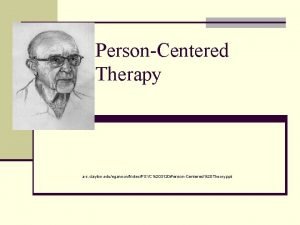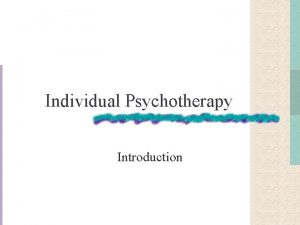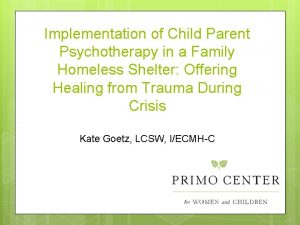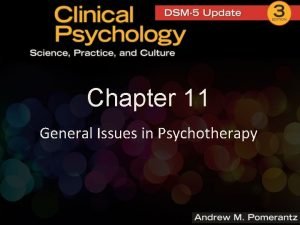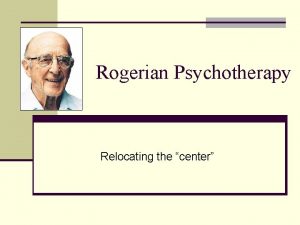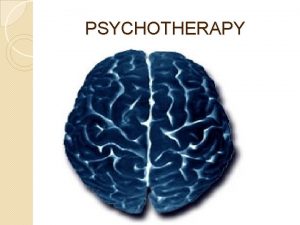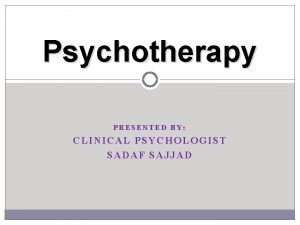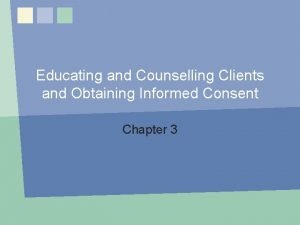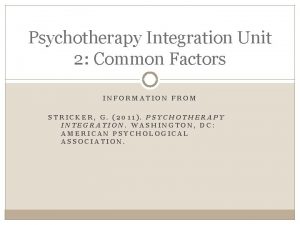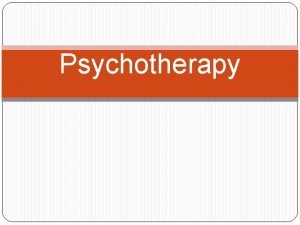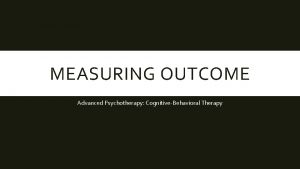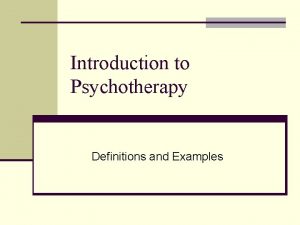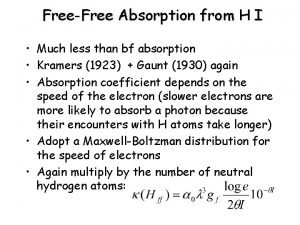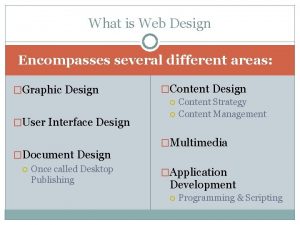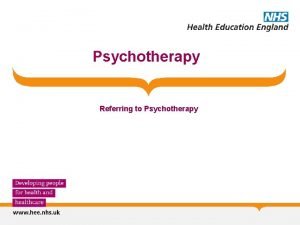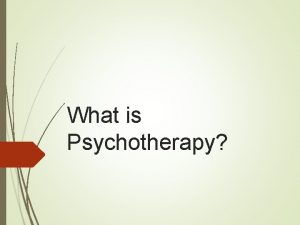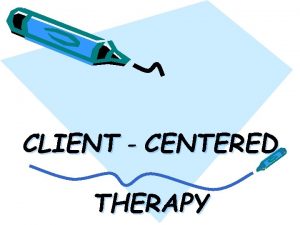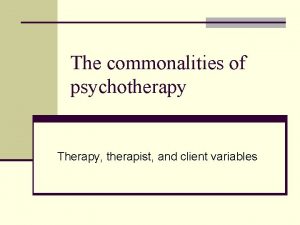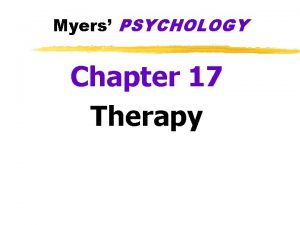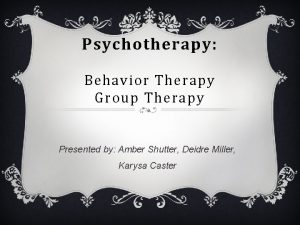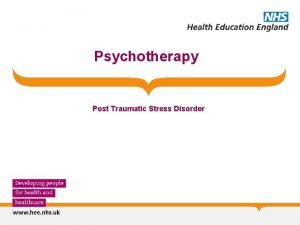Psychotherapy ASPECTS OF THERAPY A Free Choice Client






















































- Slides: 54

Psychotherapy ASPECTS OF THERAPY A. Free Choice - Client must want therapy for change

B. Hopes & Expectations 1. Expectations about the future affect the present => Belief that therapy will work = powerful treatment itself Placebo effects Hormones & immune system

2. Different expectations of therapy by client & therapist => increase similarity in expectancies

C. Therapist-Client Interaction 1. Therapist Qualities “Nonspecific Factors” - Empathy - Warmth - Genuineness

Experience Client-therapist matching

2. Therapeutic Alliance - Joint goals & how to achieve them - Therapist’s cooperative spirit - Client’s ability to trust => Stronger alliance = better outcome

Insight-Oriented Therapies Psychoanalysis & Psychoanalytic Psychotherapy 1. Assumptions a) Disorder = childhood problems & unconscious conflicts

b)Purpose of Symptoms = express conflict & protect from conscious awareness of conflict c)Goal of therapy = uncover conflict to free person from symptoms

Methods a)Therapist behavior Anonymous Abstinent Ambivalent

b) Free association & dream interpretation - analyst interprets

c)Transference - patient comes to regard therapist as parent & enacts old relationship d)Countertransference - therapist develops personal feelings for client

Psychoanalysis vs. Psychoanalytic Psychotherapy a)Time & Expense - 5 times/week for 5+ years vs. 1 -2 times/week for 1 -2 years

b)Interaction: - little vs. much therapist input - couch vs. chair - focus = child sexuality & aggression vs. other issues

Humanistic Therapy Assumptions a)Optimistic: People are good & seek selfactualization b)Disorder = incongruence - parents don’t provide unconditional positive regard - person conforms to them

c) Goal of therapy = client accepts self - restructure self-concept to match reality - strive toward self-actualization

Methods a) Therapist behavior = nonjudgmental, warm, genuine b) Relationship: Therapist & client are equals - “client” vs. “patient” - therapist is nondirective - client knows what is best - needs facilitator to discover c) Method - therapist mirrors/reflects client

Gestalt Therapy Assumptions a)Disorder = out of touch with true self - not accepting gestalt (whole) b)Goal of therapy - improve awareness of self-aspects - take responsibility for them

Methods a)Therapist behavior = confrontational & directive b)Nonverbal cues c)Role-playing - act out relationships - “empty chair” - letter writing d)Dream interpretation

Cognitive-Behavioral • WHY of behavior is unimportant • Change current thoughts/behaviors (sx focus)

Ellis’ Rational Emotive Therapy (RET) 1. Assumptions a) Disorders = irrational beliefs - perfectionism b) Goal of Therapy = substitute rational for irrational thoughts

Methods • Therapist Behavior: dispute beliefs - Therapist as Educator - Therapist & client are active - Homework

Beck’s Cognitive Therapy 1. Assumptions a) Disorders = irrational beliefs - irrational beliefs differ by disorder - Affect, Behavior, & Cognition b) Goal of Therapy = change irrational beliefs

Methods a)Therapist: warm, but disputes b)Guided Imagery: move from unrealistic fantasies toward realistic gratification c)Homework - test out irrational beliefs - situational analysis

Behavior Therapy 1. Assumptions a) Disorders = learned responses that can be unlearned - Behavior is situationally specific so treatment must be specific

b) c) Accept client’s report as valid Goal of Therapy = change maladaptive behavior - substitute adaptive behavior

Methods a) Therapist Behavior - directive, gives advice - also warm - Client controls focus of therapy - Therapist = how to change

b) Functional Analysis reinforcements & contingencies Problem - What Antecedents - When - Where Consequence - How (is problem rewarded) - Change cues/contingencies to change behavior

c)Flooding - expose to worst fears until person can tolerate without anxiety - imaginal or in vivo

d)Systematic Desensitization - gradually expose to fear - start with least fearful - in vivo or imaginal - with or without relaxation

e)Aversive Conditioning - pair negative behavior with aversive stimulus - in vivo or imaginal - last resort

Family & Couples Therapy Assumptions a)Disorder occurs in context of family & marital relationships - Communication = biggest problem - Relationship issues

b) Goal of Therapy = change interactions so that “patient” no longer needs the problem behavior

Methods a)Problem-Solving: State problem *Restate in other’s words Suggest solutions Evaluate solutions Agree on solution & try it

b)Structural Family Therapy - problems in family structure - change by “unbalancing” current system c)Family Systems Tx - reduce over-involvement - promote healthy individuation

Group Therapy Assumptions a)Advantages - Not alone in problem - Additional support of group members - Some problems = relevant for groups - Cheaper

b)Disadvantages - self-disclosure to many - confidentiality - less therapist attention

Methods: General - 8 -10 people in circle - All provide feedback & support - Therapist is less directive - Therapist may self-disclose

Methods: Specific a)Psychodrama - each person’s problems enacted as a play b)Assertiveness Training passive — assertive — aggressive c)Social Skills Training

Eclecticism Technical Eclecticism • Use techniques of different orientations • Theory: either one or none • Many therapists

Theoretical Eclecticism • Integrate different theories • Based on common principles of behavior and on nonspecific factors • Problem = basic assumptions of theories conflict

• Challenge = rigid adherence to one theory vs. superficial knowledge of several **Must have a plan, conceptualization of each case that drives therapy

Effectiveness of Psychotherapy • Outcome studies • Meta-analysis - statistical combination of many studies

Smith & Glass (1977) • 375 controlled studies • Average client better than 75% of controls Smith, Glass, & Miller (1980) • 475 controlled studies • Average client better than 80% of controls

• Some research: Effectiveness generalizes to real therapy (external validity) • Other research: research therapy vs. clinic therapy

• • Effects seen in 3 -4 months for 50% Effects seen in 6 months for 75% But, many clients terminate early Few differences among therapy types

Issues • Match therapy to problem • Match therapy to client

Ethical & Legal Issues Clients’ Rights 1. To treatment - cannot just be confined

2. To efficacious treatment - statistical vs. clinical significance - 70% spontaneous remission - but therapy is better - continued improvement - right to not be abused

Must terminate therapy (refer to someone else) if - not efficacious - problem between therapist & client

3. To confidentiality - increases trust & disclosure - exceptions: suicide/homicide child abuse subpoenas

4. To informed consent - explanation of treatment, purpose, & projected outcome 5. To refuse treatment - a limited right

Forensic Psychology Determining mental competency 1. For involuntary commitment 2. At the time of committing a crime Criteria - result of a mental disease or defect - can’t appreciate wrongfulness - can’t conform behavior to the law

Frequency - almost never used - rarely effective when used - when used and person NGRI, more time in hospital than in jail

3. At time of trial - participate in own defense 4. At time of execution - retribution
 Cultural aspects of strategy choice
Cultural aspects of strategy choice Vmatrix server manager
Vmatrix server manager Client léger client lourd
Client léger client lourd Example of two tier architecture
Example of two tier architecture Choice theory total behavior car
Choice theory total behavior car Existential theory ppt
Existential theory ppt Good choice or bad choice
Good choice or bad choice Psychodynamic and humanistic therapies have in common
Psychodynamic and humanistic therapies have in common Bioness integrated therapy system price
Bioness integrated therapy system price What are the major humanistic therapies
What are the major humanistic therapies Difference between guidance counseling and psychotherapy
Difference between guidance counseling and psychotherapy Andrew pethebridge
Andrew pethebridge Flooding ap psychology
Flooding ap psychology Re-educative individual psychotherapy
Re-educative individual psychotherapy Cpp triangle of explanation
Cpp triangle of explanation Hamid zolfaghari
Hamid zolfaghari Bracketing counseling
Bracketing counseling Dodo bird effect in psychotherapy
Dodo bird effect in psychotherapy General issues in psychotherapy
General issues in psychotherapy Carl rogers theory
Carl rogers theory Psychotherapy refers to
Psychotherapy refers to Psychotherapy definition psychology
Psychotherapy definition psychology Individual psychotherapy definition
Individual psychotherapy definition Quantum psychotherapy
Quantum psychotherapy The primary goal of cognitive psychotherapy is
The primary goal of cognitive psychotherapy is Common factors approach psychotherapy integration
Common factors approach psychotherapy integration Modelo cognitivo
Modelo cognitivo Advanced psychotherapy
Advanced psychotherapy Psychotherapy examples
Psychotherapy examples Limitations of psychotherapy
Limitations of psychotherapy College of registered psychotherapists of ontario
College of registered psychotherapists of ontario Transference meaning psychology
Transference meaning psychology Doctorate in counselling psychology
Doctorate in counselling psychology Fah nicol
Fah nicol Gibbs free energy vs standard free energy
Gibbs free energy vs standard free energy Boltzmann entropy equation
Boltzmann entropy equation Change in gibbs energy
Change in gibbs energy Allocation map
Allocation map Helmholtz free energy
Helmholtz free energy Free hearts free foreheads you and i are
Free hearts free foreheads you and i are Summary of story of an hour
Summary of story of an hour Free free absorption
Free free absorption It encompasses several different aspects, including
It encompasses several different aspects, including Concept of health and wellness
Concept of health and wellness The physical outline of a display
The physical outline of a display Trade related aspects of intellectual property rights
Trade related aspects of intellectual property rights Aspects of negro life: from slavery through reconstruction
Aspects of negro life: from slavery through reconstruction 5 themes of geography project based learning
5 themes of geography project based learning What is all aspects of software production
What is all aspects of software production Alterations in various aspects of society over time is
Alterations in various aspects of society over time is Social aspects of interlanguage
Social aspects of interlanguage Cultural aspects
Cultural aspects Repression psychology example
Repression psychology example Legal aspects of catering premises
Legal aspects of catering premises The recurring aspects of designs are called design
The recurring aspects of designs are called design





